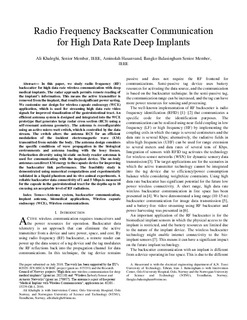| dc.contributor.author | Khaleghi, Ali | |
| dc.contributor.author | Hasanvand, Aminolah | |
| dc.contributor.author | Balasingham, Ilangko | |
| dc.date.accessioned | 2020-01-29T09:58:57Z | |
| dc.date.available | 2020-01-29T09:58:57Z | |
| dc.date.created | 2019-07-08T14:55:54Z | |
| dc.date.issued | 2019 | |
| dc.identifier.citation | IEEE transactions on microwave theory and techniques. 2019, 67 (3), 1093-1106. | nb_NO |
| dc.identifier.issn | 0018-9480 | |
| dc.identifier.uri | http://hdl.handle.net/11250/2638519 | |
| dc.description.abstract | In this paper, we study the radio frequency (RF) backscatter for high data rate wireless communication with deep medical implants. The radar approach permits remote reading of the implant's information. This means that the active transmitter is removed from the implant that results in significant power saving. We customize our design for wireless capsule endoscopy (WCE) application, which is used for streaming high data rate video signals for improved visualization of the gastrointestinal tract. An efficient antenna system is designed and integrated into the WCE prototype that generates large radar cross section (RCS) using a self-resonant antenna geometry. The antenna is reconfigurable using an active microwatt switch, which is controlled by the data stream. The switch alters the antenna RCS for an efficient modulation of the incident electromagnetic (EM) wave transmitted from outside the body. The antenna design considers the specific conditions of wave propagation in the biological environments and antenna loading with the lossy tissues. Polarization diversity using bistatic on-body reader antennas is used for communicating with the implant device. The on-body antennas can direct EM energy to the capsule device for improving the backscatter link performance. The feasibility study is demonstrated using numerical computations and experimentally validated in a liquid phantom and in-vivo animal experiments. A reliable backscatter data connectivity of 1 and 5 Mb/s is measured for the capsule in the gastrointestinal tract for the depths up to 10 cm using an acceptable level of RF radiations. | nb_NO |
| dc.language.iso | eng | nb_NO |
| dc.publisher | Institute of Electrical and Electronics Engineers (IEEE) | nb_NO |
| dc.title | Radio frequency backscatter communication for high data rate deep implants | nb_NO |
| dc.type | Journal article | nb_NO |
| dc.type | Peer reviewed | nb_NO |
| dc.description.version | acceptedVersion | nb_NO |
| dc.source.pagenumber | 1093-1106 | nb_NO |
| dc.source.volume | 67 | nb_NO |
| dc.source.journal | IEEE transactions on microwave theory and techniques | nb_NO |
| dc.source.issue | 3 | nb_NO |
| dc.identifier.doi | 10.1109/TMTT.2018.2886844 | |
| dc.identifier.cristin | 1710666 | |
| dc.description.localcode | © 2019 IEEE. Personal use of this material is permitted. Permission from IEEE must be obtained for all other uses, in any current or future media, including reprinting/republishing this material for advertising or promotional purposes, creating new collective works, for resale or redistribution to servers or lists, or reuse of any copyrighted component of this work in other works. | nb_NO |
| cristin.unitcode | 194,63,35,0 | |
| cristin.unitname | Institutt for elektroniske systemer | |
| cristin.ispublished | true | |
| cristin.fulltext | original | |
| cristin.qualitycode | 1 | |
